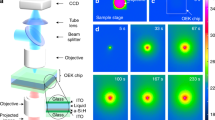Abstract
A novel on-chip environment measurement with functional gel-microtool was developed. Environment measurement gel-microtool was fabricated by connecting the gel-microbeads impregnated with indicators in a microchip. In this artcle, Bromothymol blue (BTB) and Bromocresol green (BCG) were employed as pH indicators. BTB and BCG have the different indicator range. Rhodamine B is temperature sensitive fluorescent dye and is used for temperature measurement. Gel-microbead is made by salting-out of hydrophilic photo-crosslinkable resin and is manipulated by optical tweezers. Moreover, gel-microbead is polymerized by UV illumination and connected to other gel-microbead under an electrolyte solution. The connection of gel-microbeads is performed by contact of gel-microbeads under UV illumination. Environment measurement gel-microtool with an arbitrary shape is fabricated by connection of the gel-microtool impregnated with arbitrary indicator. Multiple environments measurement gel-microtool included with several indicators is realized by assembly of the gel-microbeads impregnated with different indicators. Environment measurement is performed by detecting the color and the fluorescence intensity of each gel-microbead. We succeeded in the on-chip fabrication of the environment measurement gel-microtools such as circular pH measurement gel-microtool and wide range pH measurement gel-microtool in a microchip.








Similar content being viewed by others
References
Arai F, Yoshikawa K, Sakami T, Fukuda T (2004) Synchronized laser micromanipulation of multiple targets along each trajectory by single laser. Appl Phys Lett 85(19):4301–4303
Ashkin A, Dziedzic JM (1987) Optical trapping and manipulation of viruses and bacteria. Science 235:1517–1520
Borisov SM, Krause C, Arain S, Wolfbeis OS (2006) Composite material for simultaneous and contactless luminescent sensing and imaging of oxygen and carbon dioxide. Adv Materials 18:1511–1516
Bright GR, Fisher GW, Rogowska J, Taylor DL (1987) Fluorescence ratio imaging microscopy: temporal and spatial measurements of cytoplasmic pH. J Cell Biol 104:1019–1033
Chang C-H, Ogawa H et al (2006) Healthcare chip based on integrated electrochemical sensors used for clinical diagnostics of BUN. Jpn J Appl Phys 45:4241–4247
Cho JK, Wong LS et al (2004) PH indicating resins. Chem Commun, pp 1470–1471
Garcia C, Tziritas G (1999) Face detection using quantized skin color regions merging and wavelet packet analysis. IEEE Trans Multimed 1(3):264–277
Inoue I, Wakamoto Y, Moriguchi H, Okano K, Yasuda K (2001) On-chip culture system for observation of isolated individual cells. Lab Chip 1:50–55
Kato H, Nishizaka T, Iga T, Kinosita K, Ishiwata S (1999) Imaging of thermal activation of actomyosin motors, Proc. Proc Natl Acad Sci USA 96:9602–9606
Klauke N, Monaghan P et al (2006) Characterisation of spatial and temporal changes in pH gradients in microfluidic channels using optically trapped fluorescent sensors. Lab Chip 6:788–793
Kopelman R, Masuhara H, Sakaki K, Shi Z-Y (1996) Three-dimensional pH Microprobing with an optically-manipulated fluorescent particle. Chem Lett 25(2):141–142
Kunz W, Henle J, Ninham BW (2004) ‘Zur Lehre von der Wirkung der Salze’ (about the science of the effect of salts): Franz Hofmeister’s historical papers. Curr Opin Colloid Interface Sci 9:19–37
Maruyama H, Arai F, Fukuda T, Katsuragi T (2005) Immobilization of individual cells by local photo polymerization on a chip. Analyst 130(3):304–310
Maruyama H, Arai F, Fukuda T (2008) On-chip pH measurement using functionalized gel-microbeads positioned by optical tweezers. Lab on a Chip 7(2):346–351
Nagl S, Wolfbeis OS (2007) Optical multiple chemical sensing: status and current challenges. Analyst 132:507–511
Nakao M, Inoue S, Oishi R, Yoshinobu T, Iwasaki H (1995) Observation of microorganism colonies using a scanning-laser-beam pH-sensing microscope. J Ferment Bioeng 79(2):163–166
Nishimura G, Shiraishi Y, Hirai T (2005) A fluorescent chemosensor for wide-range pH detection. Chem Commun 42:5313–5315
Shinohara K, Sugii Y et al (2004) Measurement of pH field of chemically reacting flow in microfluidic devices by laser-induced fluorescence. Meas Sci Technol 15:955–960
Stern H, Efros B (2005) Adaptive color space switching for tracking under varying illumination. Image Vis Comput 23:353–364
Suzuki M, Tseeb V, Oyama K, Ishiwata S (2007) Microscopic detection of thermogenesis in a single HeLa cell. Biophys J 92:L46–L48
Wakamoto Y, Ramsden J, Yasuda K (2005) Single-cell growth and division dynamics showing epigenetic correlations. Analyst 130:311–317
Zhang Z, Achilefu S (2005) Design, synthesis and evaluation of near-infrared fluorescent pH indicators in a physiologically relevant range. Chem Commun 47:5887–5889
Acknowledgments
This research was supported by the Ministry of Education, Culture, Sports, Science and Technology of Japan through Grants-in-Aid for Scientific Research (Nos. 17040017, 19760170, and 17076004).
Author information
Authors and Affiliations
Corresponding author
Rights and permissions
About this article
Cite this article
Maruyama, H., Fukuda, T. & Arai, F. Functional gel-microbead manipulated by optical tweezers for local environment measurement in microchip. Microfluid Nanofluid 6, 383–390 (2009). https://doi.org/10.1007/s10404-008-0401-6
Received:
Accepted:
Published:
Issue Date:
DOI: https://doi.org/10.1007/s10404-008-0401-6




